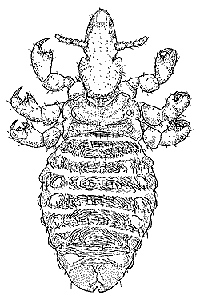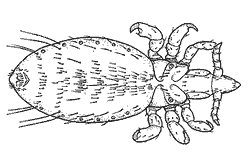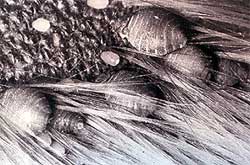|
Phthiraptera:
lice
Characteristics
Lice are
small, wingless insects that are parasites
of birds and mammals. They are usually less than 10 millimetres
in length and are rarely seen without the aid of a microscope or
magnifying glass. Lice are short lived and usually host specific.
Lice can be recognised by the following features:
 Haematopinus
asini
Haematopinus
asini
(HAEMATOPINIDAE) |
|
- Legs with
hooked tarsi
adapted to gripping their hosts
- Chewing or
biting mouthparts (biting lice) or piercing and sucking mouthparts
(sucking lice)
A few species
of lice have adapted to live and feed on humans, such as the head
louse Pediculus capitis, the eggs of which are commonly called
nits and the body louse Pediculus humanus.
Life Cycle
Lice have
relatively short lives of 2-8 weeks depending on the species. The
female lays up to 9 eggs per day on the hair or feathers of the
host. The nymphs
resemble adults and develop through 3 instars
before they reach sexual maturity.
Feeding
Most sucking lice species feed on the blood of the animals they
live on while biting lice usually feed on the feathers and skin
of their hosts. Haematopinus asini is a common louse found
feeding on horses while Linognathus species are common parasites
of domestic mammals.
Habitat
Lice are parasites of almost all birds and mammals and are found
throughout Australia where their hosts occur. Some species of lice
are restricted to just one host species and will often spend their
entire life on only one particular part of the body.
 Linognathus
vituli
Linognathus
vituli (cattle lice) |

Antarctaphthirus ogmorhini
|
|